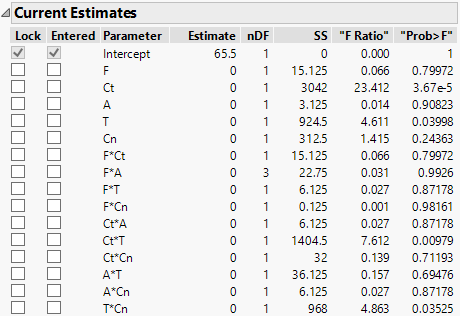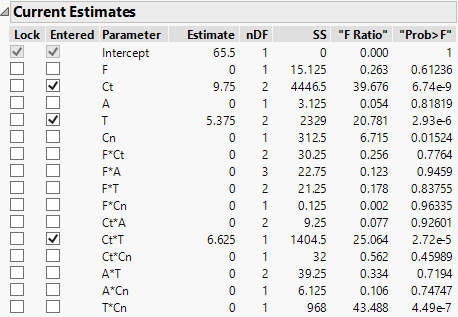Example of the Combine Rule
This example illustrates the Combine rule in the Stepwise personality of the Fit Model platform.
1. Select Help > Sample Data Folder and open Reactor.jmp.
2. Select Analyze > Fit Model.
3. Select Y and click Y.
4. In the Degree box, type 2.
5. Select F, Ct, A, T, and Cn and click Macros > Factorial to Degree.
6. For Personality, select Stepwise.
7. Click Run.
Figure 5.12 Initial Current Estimates Report Using Combine Rule
The model in Figure 5.12 contains all terms for up to two-factor interactions for the five continuous factors. The Combine, Restrict, and Whole Effects rules described in Rules enable you to control entry of interaction terms.
The Combine rule determines the entry of interaction terms based on two tests. See Combine. You can determine which of the two tests was used for the p-value based on the degrees of freedom, nDF. For example, the interaction term F*A has an nDF value of 3. This means that F*A is grouped with its precedent terms F and A, and is considered for entry based on the 3 degree of freedom joint F test. In contrast, the interaction term Ct*T has an nDF value of 1. This means that Ct*T is considered for entry based on the 1 degree of freedom F test that tests the significance of Ct*T after its precedent terms, Ct and T, are already included in the model. Click Step once to see that Ct is entered by itself.
8. Click Step again to see that Ct*T is entered, along with T (Ct is already in the model).
Figure 5.13 Current Estimates Report Using Combine Rule, One Step
When there are significant interaction terms, several terms can enter at the same step. If the Step button is clicked twice, Ct*T is entered along with its two contained effects Ct and T. However, a step back is not symmetric because a crossed term can be removed without removing its two component terms. Notice that Ct and T now each have 2 degrees of freedom. This is because if Stepwise removes Ct or T, it must also remove Ct*T. If you change the Direction to Backward and click Step, Ct*T is removed and the degrees of freedom for Ct and T change to 1.

